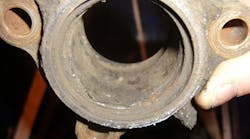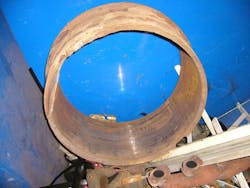When the costs hit the reports, it is too late. Data is good, but maybe too late! You have to cure the root cause.
There are some simple ways to figure out where you might start to reduce costs. Here are a couple of quick methods that I have been practicing and never will give up.
Trash Cans
Tour every day through your shop and look in all of your trash cans. Look for valve cores, flaps cut too short, expensive fittings still remaining in the foot valve, or maybe where the mechanics cut the plastic lines in lieu of removing them. Do you see more air filters than you would like to see knowing that you are or supposed to be changing them by restriction? You may find out that some of your employees are on their own replacement program.
Steel Dumpster/Pile
Try removing some of the brake drums or rotors and measure them. You may find out that the mechanics are removing them to early, or too late. You may see some drums or rotors cracked and way beyond reasonable life and that is why they cracked. You may see a drum, or what’s left of it.
You recently asked for a reduction in inventory and to return slow moving parts to the vendors. Maybe you just saw where they went. Now there may be a good reason, but maybe it was just easier.
Benches
Open your eyes to the shop benches. Are there drill bits, half full cans of spray something, tools strewn on the bench, some theirs some the companies, or maybe an expensive battery electronic load tester that the tech on the other side of the shop has been looking for 20 minutes (at a $1.00 a minute)? See if you see that on the monthly P&L.
Corners of the shop
Look -- cores, grease guns, shoe cores, broken tools, old drop light cords, creepers with 3 wheels, and a radio that is broken. They now used IPhones with ear buds, if we allow it. Stuff/junk placed on the ledges of the shop walls. If it fits, it will be there even if the trash can is within arm’s reach.
Changing Room/Locker Area
This one is simple. Boots all the place, maybe 22 pairs for only 12 mechanics. Inappropriate material dangling from the walls or on the front of the lockers. Extra pairs of pants or coveralls belonging to someone who no longer works for the company.
Bathroom
No supplies, dirty floor, cloth towels on the floor. Three dispensers for hand cleaner, two old and a new one from a new vendor. Dirty mirror, a dripping faucet and no hot water to wash with. This area screams help.
Lunch room
Crappy, dirty picnic table for lunch, E.coli everywhere. Ash trays in a no smoking building and a coffee make and refrigerator that looks like it breeding pets and a freezer that the door won’t shut tight.
Yard
Tour the yard. Look at your equipment. Take an employee with you to train on the fly. Based on what you see or what your stomach tells you is going on, check PM status.
Parts room
Plenty of stuff here since 50% of the cost goes thought this department. Overstuffed bins that are dirty, too many air filters, brass galore, three types of silicone or the wrong rollup door lube as well as only one door cable when your policy is to replace both at the same time when one fails. Brake shoes, but no drums and three different brands of seals under three different part numbers. One autoslack adjuster and seven manuals slacks. Shoe cores that tell you the state of your brake maintenance program in a split second.
Tire Area
Tires will talk to us, if we listen. Take a quick mental snap shot here.
All of these suggestions may already be part of your arsenal, but does your staff understand the importance of observation? Sometime we create our own bureaucracy and overload our supervisors with corporate desk busy work. I see it every day. Be careful, sending an email doesn’t fix these issues. It takes pure leadership and discipline at all levels, starting with us.





